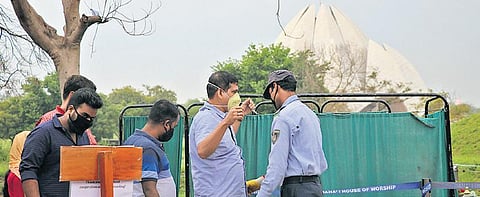

NEW DELHI: The government on Saturday declared the coronavirus (COVID-19) outbreak as a “notified disaster” and asked state governments to use State Disaster Response Fund to tackle the pandemic even as the Centre also announced that the Padma award ceremony, scheduled for March 26 and April 3, had been postponed. Described as “a special one-time dispensation,” the directive to use the SDRF for COVID-19 is to ensure that state governments do not face a shortage of funds while dealing with the crisis. The government’s step came amid reports of several suspected patients slipping out of hospitals and not observing quarantine protocols.
The latest instance was reported from Nagpur, where five suspected coronavirus patients escaped from a hospital on Friday night. One of them had tested negative while the results of the rest are awaited. The Centre also issued detailed home-isolation guidelines that need to be observed by people showing signs of infection but have not been hospitalized. The guidelines will also apply to care-givers at home or people who have come into close contact with confirmed cases.
The SDRF is the primary fund available with states for responses to notified disasters like floods, earthquakes etc. While the Centre contributes 90 per cent of the funds to the SDRF, states incur 10 per cent of the expenditure. In a two-page statement, the Union Ministry of Home Affairs (MHA) said states can draw money from the SDRF for temporary accommodation and supply of food, water and medical care for patients and people in quarantine camps.
The MHA directed the chief secretaries to ensure effective containment of the outbreak for a period of up to 30 days, as per assessment of need by State Executive Committee (SEC). “The SEC will decide the number of quarantine camps, their duration, and the number of persons in such camps. This period can be extended by the SEC beyond the prescribed limit,” the MHA said. SDRF funds will also be used, the government said, to pay for additional testing centres and the cost of protective equipment for police, healthcare and municipal authorities, as well as that of thermal scanners, ventilators, air purifiers and consumables for government hospitals.
MHA retracts Rs 4L ex-gratia statement
Such expenditure, the government added, will be drawn only from the state’s funds and not the National Disaster Response Fund (NDRF). The Centre specified that total expenditure on equipment cannot exceed 10 per cent of the fund’s annual allocation. The government’s announcement on SDRF was marred by some controversy though. In the afternoon, the MHA announced that exgratia relief of Rs 4 lakh would be paid to the families of those who died due to the virus.
But hours later, it issued a revised circular, deleting the compensation clause. In the first circular, the MHA had also stated that the cost of hospitalization for managing COVID-19 cases would have to be carried out at rates fixed by the state government (in case a patient gets admitted to a private hospital). In the revised circular, this clause was deleted as well. Meanwhile, four Indo-Nepal border checkposts will be operational. For citizens of Bhutan and Nepal visafree entry will continue.